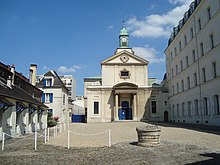Picpus Cemetery

Cemetery entrance next to chapel Notre-Dame-de-la-Paix
|
|
| Location within Paris | |
| Details | |
|---|---|
| Established | 13 June 1794 |
| Location | 35 rue de Picpus, Paris |
| Country |
|
| Coordinates | 48°50′38″N 2°24′00″E / 48.8440°N 2.4001°E |
| Type | Private |
| Size | 2.1 hectares (5.2 acres) |
| No. of graves | unknown |
| No. of interments | 1,306 (two mass graves) |
| Find a Grave | Cimetière de Picpus |
Picpus Cemetery (French: Cimetière de Picpus) is the largest private cemetery in Paris, France, located in the 12th arrondissement. It was created from land seized from the convent of the Chanoinesses de St-Augustin, during the French Revolution. Just minutes away from where the guillotine was set up, it contains 1,306 victims executed between June 14 and 27 July 1794, during the height of the Reign of Terror. Today only descendents of those 1,306 victims are eligible to be buried at Picpus Cemetery.
Picpus Cemetery is one of only two private cemeteries in Paris, the other being the old Cimetière des Juifs Portugais de Paris in the 19th arrondissement.
Picpus Cemetery is situated next to a small chapel, Notre-Dame-de-la-Paix ("Our Lady of Peace"), run by the Sisters of the Sacred Heart. The priests of the Congregation of the Sacred Hearts are referred to as "The Picpus Fathers" because of the order's origins on the street. It holds a small 15th-century sculpture of the Vierge de la Paix, reputed to have cured King Louis XIV of a serious illness on 16 August 1658.
The cemetery is of particular interest to American visitors as it also holds the tomb of the Marquis de Lafayette (1757–1834), over which an American flag is always present.
The entrance to the cemetery is at 35 rue de Picpus in the 12th arrondissement. It can be visited in the afternoon every day except Sunday and holidays, with hours usually from 2 pm to 5 pm (Admission: €2). The is located at the entrance of the cemetery. The nearest Paris metro stations are Nation and Picpus.
...
Wikipedia

